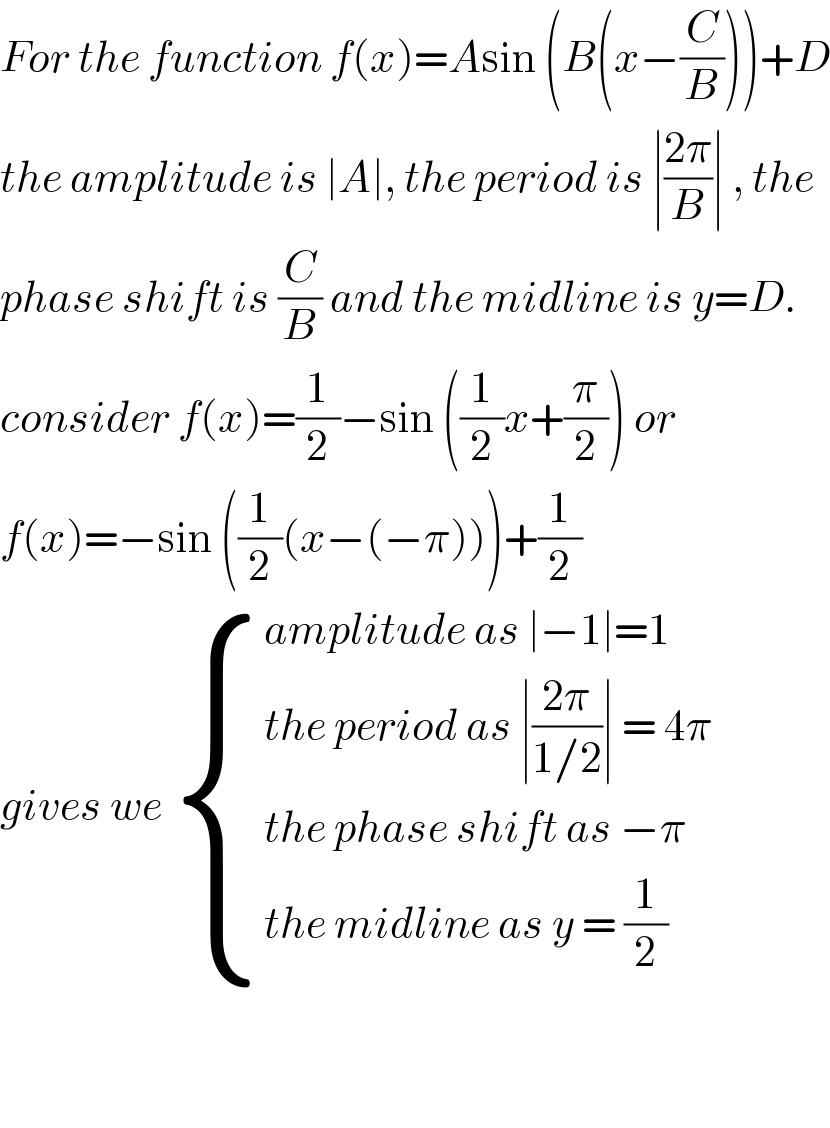Question Number 125993 by bramlexs22 last updated on 16/Dec/20

$${Determine}\:{the}\:{amplitudo},\:{the} \\ $$$${period}\:,\:{the}\:{phase}\:{shift}\:{and}\:{the} \\ $$$${midline}\:{of}\:{the}\:{function}\: \\ $$$${f}\left({x}\right)\:=\:\frac{\mathrm{1}}{\mathrm{2}}−\mathrm{sin}\:\left(\frac{\mathrm{1}}{\mathrm{2}}{x}+\frac{\pi}{\mathrm{2}}\right) \\ $$
Answered by liberty last updated on 16/Dec/20

$${For}\:{the}\:{function}\:{f}\left({x}\right)={A}\mathrm{sin}\:\left({B}\left({x}−\frac{{C}}{{B}}\right)\right)+{D} \\ $$$${the}\:{amplitude}\:{is}\:\mid{A}\mid,\:{the}\:{period}\:{is}\:\mid\frac{\mathrm{2}\pi}{{B}}\mid\:,\:{the} \\ $$$${phase}\:{shift}\:{is}\:\frac{{C}}{{B}}\:{and}\:{the}\:{midline}\:{is}\:{y}={D}. \\ $$$${consider}\:{f}\left({x}\right)=\frac{\mathrm{1}}{\mathrm{2}}−\mathrm{sin}\:\left(\frac{\mathrm{1}}{\mathrm{2}}{x}+\frac{\pi}{\mathrm{2}}\right)\:{or}\: \\ $$$${f}\left({x}\right)=−\mathrm{sin}\:\left(\frac{\mathrm{1}}{\mathrm{2}}\left({x}−\left(−\pi\right)\right)\right)+\frac{\mathrm{1}}{\mathrm{2}} \\ $$$${gives}\:{we}\:\begin{cases}{{amplitude}\:{as}\:\mid−\mathrm{1}\mid=\mathrm{1}}\\{{the}\:{period}\:{as}\:\mid\frac{\mathrm{2}\pi}{\mathrm{1}/\mathrm{2}}\mid\:=\:\mathrm{4}\pi\:}\\{{the}\:{phase}\:{shift}\:{as}\:−\pi\:}\\{{the}\:{midline}\:{as}\:{y}\:=\:\frac{\mathrm{1}}{\mathrm{2}}}\end{cases} \\ $$$$ \\ $$$$ \\ $$
